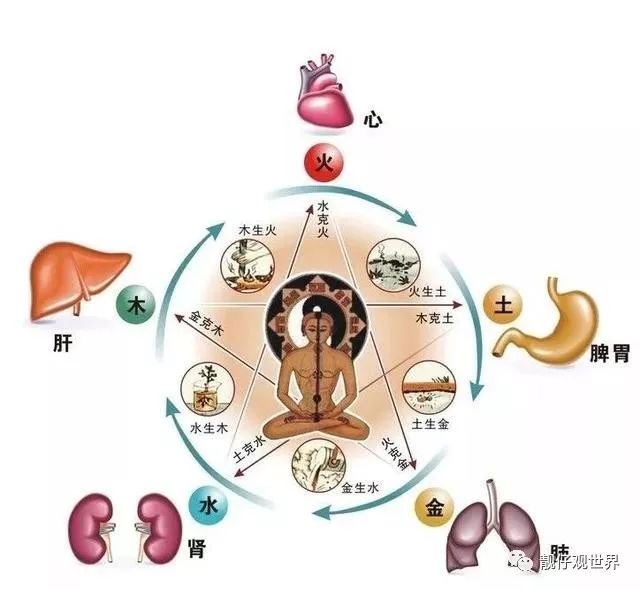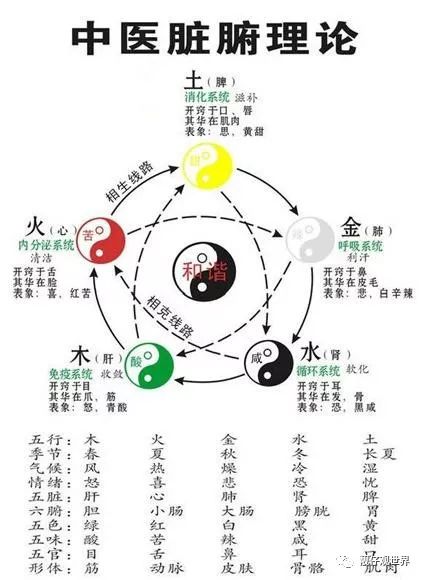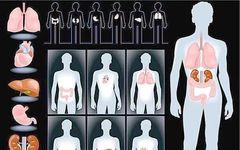The “Su Wen: On the Distinction of the Five Zang” states: “The five zang store essence and qi without leaking.” In Traditional Chinese Medicine (TCM), the five zang organs refer to the liver (Gan), heart (Xin), spleen (Pi), lungs (Fei), and kidneys (Shen), with their primary function being the storage of essence and qi.

(1) Liver (Gan)
The liver is located under the right rib cage and primarily functions to store blood and regulate the flow of qi.
① Store Blood. The ancient physician Wang Bing stated, “The liver stores blood; when a person moves, blood flows through the meridians; when at rest, blood returns to the liver for storage.” The liver acts as a “reservoir” for blood. When the body is at rest, such as lying down, the demand for blood decreases, allowing more blood to be stored in the liver. During physical activity, the body requires more energy and oxygen, prompting the liver to release stored blood to support normal physiological functions. Thus, the liver serves a dual role as a “blood reservoir” and a “regulator of blood volume.”
② Regulate Qi Flow. The liver qi has the function of spreading and harmonizing. The liver’s ability to regulate qi can smooth the qi of the spleen and stomach and also influence the emotional state of the individual. If the liver’s function is impaired, it can lead to digestive issues, irritability, anger, and insomnia.
③ Other Functions of the Liver. Due to its roles in storing blood and regulating flow, the liver also nourishes tendons and eyes.
(2) Heart (Xin)
The heart is located in the center of the chest, slightly to the left, and serves as the hub of life activities, primarily responsible for promoting blood circulation and regulating mental state.
① Promote Blood Circulation. Blood provides nourishment to the body, circulating through the vessels. Only with normal blood flow can the body receive adequate nutrition for physiological activities. The heart is the main driver of blood circulation; if heart function weakens, blood flow is obstructed, leading to symptoms such as malnutrition, pallor, and weak pulse.
② Regulate Mental State. Essence and qi are stored in the heart, and the mind is a manifestation of essence and qi. Therefore, the heart regulates mental state. If the heart is diseased, symptoms such as forgetfulness, insomnia, and mental confusion may arise.
③ Other Functions of the Heart. The heart is closely related to sweat secretion, as sweat is transformed from body fluids under the heart’s influence and expelled through the skin. The heart’s qi and blood connect with the tongue, maintaining its physiological functions. Abnormalities in the tongue, such as redness or ulceration, may indicate heart dysfunction.

(3) Spleen (Pi) The spleen is located in the middle jiao and primarily functions in transportation, nourishing muscles, and regulating blood.
① Transportation. The spleen is responsible for the transformation and transportation of food and fluids. It assists the stomach in digestion and absorbs nutrients from digested food. After digestion, the spleen transports these nutrients to the lungs and then throughout the body, providing energy for physiological activities.
② Nourish Muscles. Nutrients absorbed by the spleen are partially sent to the muscles, ensuring they receive adequate nourishment, which is essential for muscle fullness and strength.
③ Regulate Blood. The spleen’s ability to transform food and fluids is fundamental to the generation of qi and blood, allowing it to regulate blood flow and prevent blood leakage.
(4) Lungs (Fei)
The lungs are located centrally in the chest and are positioned higher than any other organ, primarily responsible for respiration and regulating fluid pathways.
① Main Function of Respiration. The lungs facilitate breathing, allowing the intake of fresh air and the expulsion of waste gases. Through the lungs, the body can perform normal respiration, converting inhaled air and nutrients into essential qi, which regulates physiological activities and influences breathing and voice.
② Regulate Fluid Pathways. The lungs manage the movement of fluids in the body, promoting smooth metabolism of body fluids. If lung function is impaired, issues such as urinary difficulties and edema may occur.
③ Other Functions of the Lungs. The lungs are closely related to the nose, which serves as the passage for lung qi. Normal lung function ensures smooth breathing and proper nasal function; conversely, lung dysfunction can lead to nasal issues. The lungs also nourish the skin and hair through their regulation of fluid pathways.
(5) Kidneys (Shen)
The kidneys are located in the lower back and primarily function to store essence and regulate water.
① Store Essence. The essence stored in the kidneys includes both congenital essence and acquired essence. Congenital essence is the source of life inherited from parents, promoting growth and reproduction; acquired essence is derived from food and provides nourishment for physiological activities.
② Regulate Water. The kidneys manage the body’s fluids, warming and transforming them for optimal function. They also transport excess water to the bladder for excretion.
③ Other Functions of the Kidneys. The kidneys also nourish the bones and promote brain development.
The “Su Wen: On the Distinction of the Six Fu” states: “The six fu transmit and transform substances without storing them.” The six fu organs include the gallbladder (Dan), small intestine (Xiao Chang), stomach (Wei), large intestine (Da Chang), bladder (Pang Guang), and san jiao (Three Jiao). Their function is to transport and process food and fluids, detailed as follows:

(1) Gallbladder (Dan)
The gallbladder is attached to the liver and functions to store and excrete bile and regulate emotions.
① Store and Excrete Bile. The gallbladder stores bile and releases it into the small intestine, aiding in digestion.
② Regulate Emotions. The gallbladder also influences emotional states; dysfunction can lead to symptoms such as fear, irritability, insomnia, and vivid dreams.
(2) Small Intestine (Xiao Chang)
The small intestine is located in the abdominal cavity and primarily promotes food digestion. Food enters the stomach, is processed, and then moves to the small intestine for further digestion. The small intestine separates nutrients for absorption and waste for excretion. Dysfunction can lead to diarrhea and malnutrition.
(3) Stomach (Wei)
The stomach is located below the diaphragm, connecting the esophagus and small intestine, and functions to receive and digest food. It acts as a natural container for food, processing it for further digestion in the small intestine. Abnormal stomach function can lead to symptoms such as vomiting, nausea, and stomach pain.
(4) Large Intestine (Da Chang)
The large intestine is located between the small intestine and the anus, functioning to transform food waste into feces. It absorbs water from waste, forming stool for excretion. Dysfunction can lead to diarrhea or constipation.
(5) Bladder (Pang Guang)
The bladder is located in the lower abdomen and connects to the urethra, primarily converting excess fluids and waste into urine. The kidneys assist in this process, and dysfunction can lead to urinary difficulties.
(6) San Jiao (Three Jiao)
The san jiao is not a distinct organ but a concept encompassing the functions of various organs. It includes the upper jiao (heart and lungs), middle jiao (spleen and stomach), and lower jiao (liver, kidneys, large intestine, small intestine, and bladder), primarily responsible for nutrient transport and waste elimination.

